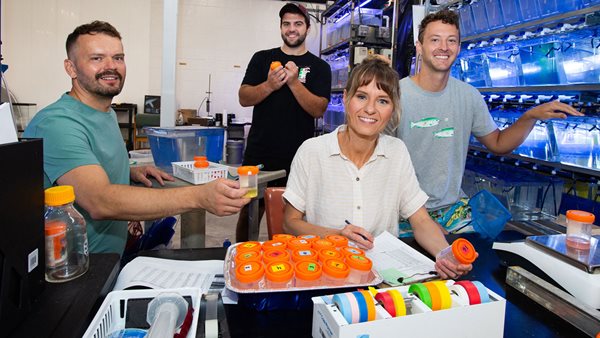Two researchers at Southern Illinois University are trying to create a new feed for fish farmers that's made from Asian carp.
Karolina Kwasek and Michal Wojno are trying to find better ways to hatch and successfully raise yellow perch. Their plan is to combine low-tech hatchery equipment, easily copied by professional fish farmers, with creating a new feed that uses the invasive species as a protein source.
The research will last through 2023. Success would mean greatly increasing yellow perch’s survival rates at indoor hatcheries, and better prices for consumers.
Yellow perch and walleye are picky eaters, and among the most difficult freshwater fish to raise in captivity, with a less than 10% success rate in nursing them from larvae.
“It’s been very difficult finding a solution for not just the right nutritional composition of food, but also making it digestible and palatable to the larvae,” Kwasek said.
In one of the fisheries buildings at SIU, Wojno and Kwasek have set up a system designed to more closely resemble a fish farm than a scientific laboratory.
Scientists have long been looking for ways to control the Asian carp, a large, leaping menace that has overtaken Midwestern rivers and lakes. One way is to convert the carp's protein into a new feed for the larvae essentially by pre-digesting it into molecular sizes that the larvae can absorb.
The final dried product is turned into pellets so small that they appear as powder to the human eye.
“It could potentially change the way the aquaculture industry is conducted everywhere,” she said. “Not many fish farmers do indoor hatchery operations, but when you think about the economics, indoor culture makes more sense because you get more fish at the end. With a pelletized food, you can pretty much drop it into the tank if they will eat it and grow on it. That’s what we’re hoping achieve.”
The methods already have raised the perch larvae's survival rate to around 50%.
(Photo by Russell Bailey/SIU)
Advertisement
SIU researchers working to make fish food from Asian carp
Advertisement
Latest Local & Regional
Local & Regional
3 hours ago
Local & Regional
7 hours ago
Local & Regional
yesterday
Local & Regional
yesterday
Local & Regional
Jan. 09, 2026
ADVERTISEMENT
Most Read >
ADVERTISEMENT
Latest Local & Regional
Local & Regional
3 hours ago
Local & Regional
7 hours ago
Local & Regional
yesterday
Local & Regional
yesterday
Local & Regional
Jan. 09, 2026
Advertisement
ADVERTISEMENT





